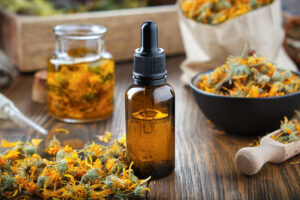Nothing will ruin your day like finding mold in your infused oil!
1. How mold shows up in infused oils
Visual signs to watch for
If you see any of these, don’t use the oil:
-
Fuzzy spots or “islands”
-
White, grey, green, blue, or black fuzzy patches
-
Often on the surface of the oil or stuck to floating herb bits
-
-
Slimy strings or clumps
-
“Ropey” strands when you pour or stir the oil
-
-
Cloudy pockets that don’t go away
-
Not just sediment, but opaque blobs or a milky layer that looks “alive”
-
-
Wet-looking plant material
-
Herbs that look swollen, mushy, or slimy inside the oil
-
-
A layer of water at the bottom
-
Clear or cloudy liquid separate from the oil—that’s water, and that’s where microbial growth can happen
-
Where to look carefully
-
Around the rim and threads of the jar
-
The underside of the lid
-
Top surface, especially if some herbs are poking above the oil
Use good light and tilt/rotate the jar slowly to inspect.
2. How it smells when it’s gone off
Trust your nose. Healthy infused oil should smell like:
-
The carrier oil (mild, nutty, or neutral)
-
The herb (green, floral, resinous, etc.)
Signs something’s wrong:
-
Musty, basement, or “wet cardboard” smell → microbial spoilage
-
Cheesy, rancid, or “old nuts/crayons” → oxidized/rancid oil
-
Sour, fermented, funky (not just strong)—especially if you used fresh material
If your body recoils and you think, “Mm, I don’t want that on my skin,” that’s your answer. Don’t try to rescue it.
3. Can I just scrape off the mold?
Short answer: No. Toss the whole jar.
Once you have visible mold or confirmed spoilage:
-
The whole jar is compromised
-
Microbial growth (including mold and bacteria) can extend beyond where you see it
-
Scraping the top doesn’t make it safe again
Especially with fresh herbs, garlic, roots, or anything watery, there is also the risk of botulism in anaerobic, low-acid, oil environments. You can’t see or smell botulism toxin—so if you’re suspicious at all, do not use it.
Herbal kitchen rule: “When in doubt, throw it out.” The cost of oil and herbs is insignificant compared to the cost of a serious illness.
4. Why mold happens in infused oils
Common reasons:
-
Using fresh plant material with lots of water and not handling it carefully
-
Herbs that weren’t dry enough
-
Oil is not fully covering the herbs.
-
Condensation inside the jar
-
Infusing in a very humid, warm area
-
Jars or utensils are not properly cleaned and dried before use

5. How to prevent mold in future infusions
This is the part you can really control.
For room-temperature oil infusions
Best easiest practice: use dried herbs. If using fresh make sure you allow them to wilt and release excess water for at least a few hours, I place them on a towel to release moisture.
-
Make sure herbs are truly dry (crispy, not leathery)
-
Use clean, dry jars and utensils
-
Completely cover herbs with oil—no leaves or flowers poking above the surface
-
Label with date + herb + oil
-
Store in a cool, dark place
-
Shake gently every few days and check visually
-
Strain after a reasonable time (usually 2–6 weeks)
For fresh-plant oil infusions (higher risk, so extra care)
If you choose to use fresh plant material:
-
Use plants that aren’t dripping wet—wilt them a bit first (remove some surface moisture)
-
Use a higher oil-to-plant ratio (lots of oil, not a packed jar of fresh greens)
-
Infuse gently with low heat (yogurt maker, dehydrator, warm-water bath) to help drive off water
-
Keep jar loosely covered during warm infusion so moisture can escape
-
Once strained and fully cooled, re-jar in sterile, dry glass, cap tightly, and refrigerate
-
Use within a short window (weeks, not a year)
And again: if you see a cloudy water layer, fuzzy anything, or smell something off, it goes in the trash.
6. Quick yes/no checklist for a questionable oil
Ask yourself:
-
Do I see fuzz, slime, or unusual clumps? → Toss
-
Does it smell musty, sour, or rancid? → Toss
-
Is there a water layer at the bottom? → Toss
-
Did I use fresh garlic or roots and it’s been sitting at room temp a while? → Toss
If all answers are “No,” and it looks and smells like normal oil + herb, you’re likely fine.
Disclaimer
Disclaimer Blog
The information presented on the Heart of Herbs Herbal School/Demetria Clark websites is for educational purposes only. Heart of Herbs Herbal School/Demetria Clark Education LLC makes neither medical claims nor intends to diagnose or treat medical conditions. Links to external sites are for informational purposes only. Heart of Herbs Herbal School/Demetria Clark neither endorses them nor is in any way responsible for their content. Readers must do their own research regarding the safety and usage of any herbs, recipes, or supplements.
Affiliate Disclosure
Some posts contain affiliate links. When you click on these and make a purchase the cost is the same for you, but we earn a small commission that helps me to provide scholarships to students. We only promote products that we know our clients have liked themselves.
Heart of Herbs Herbal School is a Amazon affiliate. As an Amazon Associate, we earn from qualifying purchases.

